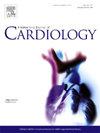Percutaneous coronary intervention of the left main coronary artery bifurcation: Insights from the PROGRESS-BIFURCATION registry
IF 3.2
2区 医学
Q2 CARDIAC & CARDIOVASCULAR SYSTEMS
引用次数: 0
Abstract
Background
There is limited data on the long-term outcomes of percutaneous coronary intervention (PCI) in patients with left main coronary artery (LM) bifurcation lesions.
Methods
This observational, cohort study was performed across 6 centers in the United States, Russia, and Turkey between 2013 and 2024, as part of the Prospective Global Registry of Percutaneous Coronary Intervention in Bifurcation Lesions (PROGRESS-BIFURCATION, NCT05100992). We examined procedural characteristics and follow-up outcomes of patients with versus without LM bifurcation lesions undergoing PCI. Multivariable adjusted hazard ratios (aHR) with 95 % confidence intervals [CI] were calculated using mixed effects Cox regression.
Results
Of 1171 patients who underwent bifurcation PCI, 308 (26.3 %) underwent LM PCI. Patients in the LM group were older (76.3 ± 11.0 vs 65.5 ± 11.5 years; p < 0.001) and had more comorbidities, such as diabetes, heart failure, prior PCI, and prior coronary artery bypass graft surgery. Two-stent techniques were more commonly used in LM vs. non-LM patients (38.7 % vs 26.2 %, p < 0.001), with similar technical (95.6 % vs 94.8 %, p = 0.56) and procedural (90.6 % vs 91.1 %; p = 0.796) success. Side-branch occlusion was less common in LM patients (4.0 % vs 16.9 %, p < 0.001). During a median follow-up period of 1095 days, LM bifurcation PCI patients had higher incidence of major adverse cardiac events (MACE) (aHR 1.91; 95 % CI 1.42–2.56;p < 0.001) and all-cause mortality (aHR 2.29; 95 % CI 1.55–3.41; p < 0.001) compared with non-LM bifurcation PCI patients. There was no difference between groups in the incidence of other individual components of MACE.
Conclusion
Compared with patients undergoing non-LM bifurcation those who underwent LM bifurcation PCI were older, had more comorbidities, similar procedural success but higher follow-up MACE and mortality.
求助全文
约1分钟内获得全文
求助全文
来源期刊

International journal of cardiology
医学-心血管系统
CiteScore
6.80
自引率
5.70%
发文量
758
审稿时长
44 days
期刊介绍:
The International Journal of Cardiology is devoted to cardiology in the broadest sense. Both basic research and clinical papers can be submitted. The journal serves the interest of both practicing clinicians and researchers.
In addition to original papers, we are launching a range of new manuscript types, including Consensus and Position Papers, Systematic Reviews, Meta-analyses, and Short communications. Case reports are no longer acceptable. Controversial techniques, issues on health policy and social medicine are discussed and serve as useful tools for encouraging debate.
 求助内容:
求助内容: 应助结果提醒方式:
应助结果提醒方式:


